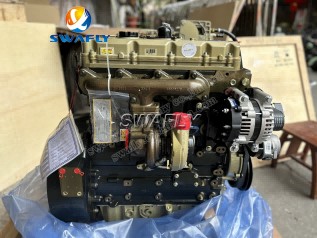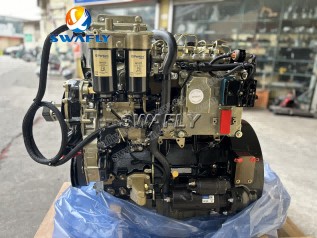
- English
- Español
- Português
- русский
- Français
- 日本語
- Deutsch
- tiếng Việt
- Italiano
- Nederlands
- ภาษาไทย
- Polski
- 한국어
- Svenska
- magyar
- Malay
- বাংলা ভাষার
- Dansk
- Suomi
- हिन्दी
- Pilipino
- Türkçe
- Gaeilge
- العربية
- Indonesia
- Norsk
- تمل
- český
- ελληνικά
- український
- Javanese
- فارسی
- தமிழ்
- తెలుగు
- नेपाली
- Burmese
- български
- ລາວ
- Latine
- Қазақша
- Euskal
- Azərbaycan
- Slovenský jazyk
- Македонски
- Lietuvos
- Eesti Keel
- Română
- Slovenski
- मराठी
- Srpski језик
Perkins κινητήρας Count: Ξεκλείδωμα του κώδικα στον πυρήνα ισχύος
2025-02-10
I. Introduction
In the realm of power equipment, particularly the "heart" of machinery—the engine—Perkins engines have distinguished themselves with exceptional reliability, high efficiency, and broad applicability across industries such as industrial, agricultural, transportation, and construction machinery. From providing robust power for large excavators on construction sites to ensuring efficient project progress, to serving as the power source for agricultural irrigation equipment, aiding in the healthy growth of crops, and even delivering stable power for ships navigating vast oceans, Perkins engines are ubiquitous.
Within their intricate and sophisticated internal structures, there is a seemingly inconspicuous parameter that plays a pivotal role in engine performance: the tooth count. The tooth count acts like a "code" for engine operation. The number of teeth and their arrangement across different gears profoundly influence the stability of power output, fuel efficiency, and overall operational performance. Today, let us delve into the mysteries of the tooth count in Perkins engines.

II. Overview of the Perkins Engine Family
The history of Perkins engines dates back to 1932. Since its inception, the company has consistently explored the forefront of engine technology. Initially focused on steam engine production, Perkins transitioned to the research and manufacturing of internal combustion engines as technology advanced. With its superior technology and reliable quality, Perkins gradually grew into a globally renowned engine manufacturer.
Today, the Perkins engine family encompasses a wide range of types, including diesel, gasoline, and gas engines. Diesel engines, known for their high fuel efficiency and torque, excel in scenarios requiring sustained high power output, such as large transport trucks, construction machinery, and agricultural irrigation equipment. Gasoline engines, with their high rotational speed and quick response, are favored in applications demanding speed and flexibility, such as small yachts, light vehicles, and certain landscaping equipment. Gas engines, benefiting from growing environmental awareness and the widespread use of natural gas, are gaining traction due to their clean emissions and high combustion efficiency, particularly in distributed power generation and urban public transportation.
In the marine sector, Perkins engines power everything from luxurious yachts to cargo ships and ferries, providing reliable and efficient power for safe navigation. In power generation, Perkins engines ensure stable electricity supply, whether in remote areas or as backup power for large factories. In agriculture, Perkins engines serve as the core power source for tractors, harvesters, and other machinery, driving the modernization and efficiency of agricultural production.
III. Tooth Count: The Invisible "Regulator" of Engines
(A) The Close Relationship Between Tooth Count and Engine Operation
Tooth count plays a crucial role in engine operation, acting as an invisible "regulator" that precisely controls various engine performance metrics. From a power output perspective, the number of teeth directly affects engine torque. Generally, under the same conditions, gears with more teeth can transmit greater torque due to their larger size and increased contact area between teeth. For instance, in heavy machinery like large loaders, a higher tooth count ensures sufficient torque to lift heavy loads effortlessly.
Additionally, tooth count significantly impacts engine speed stability. Improper tooth count can lead to speed fluctuations during operation. For example, sudden acceleration from low to high speed with poorly designed tooth counts can cause unstable power transmission, resulting in abrupt speed changes that not only disrupt equipment operation but also cause additional wear and tear on engine components. Perkins engines, with their meticulously designed tooth counts, maintain stable speeds across various operating conditions, providing reliable power support.
Moreover, tooth count is closely tied to fuel efficiency. Proper tooth count ensures optimal power output and fuel consumption ratios. At lower speeds, a well-designed tooth count can deliver sufficient torque while reducing fuel consumption, as the engine operates more efficiently with better component coordination. For example, in long-haul trucks, optimizing tooth count in Perkins engines can significantly lower fuel consumption, reducing operating costs.
(B) The Unique Roles of Tooth Counts in Different Components
In the complex and precise mechanical system of a Perkins engine, tooth counts in different components serve unique purposes, working together to ensure smooth operation.
· Crankshaft Gear: The tooth count of the crankshaft gear directly influences overall engine performance. Typically, larger engines with more cylinders have crankshaft gears with more teeth to ensure stable torque output and rotational speed. For example, in large construction machinery, the crankshaft gear's tooth count is carefully calculated to deliver robust power under high loads.
· Camshaft Gear: The camshaft gear controls the timing and sequence of valve openings and closings. The tooth count ratio between the camshaft and crankshaft gears, known as the gear ratio, ensures precise valve operation. In a four-stroke engine, the crankshaft gear typically has twice as many teeth as the camshaft gear to synchronize valve movements with piston cycles.
· Speed Sensor Gear: This gear provides accurate speed signals to the engine's electronic control system. Its tooth count is designed to ensure precise speed measurement. For instance, in modern automotive engines, the speed sensor gear's tooth count allows the electronic control system to adjust fuel injection and ignition timing accurately, enhancing performance and fuel efficiency.
In summary, the tooth counts of crankshaft, camshaft, and speed sensor gears, though serving distinct roles, work in harmony to create an efficient and stable engine system. Any deviation in tooth count can adversely affect overall engine performance.

IV. Unveiling the Secrets of Perkins Engine Tooth Counts
(A) Tooth Count Overview of Common Models
Perkins engines come in various models, each with different tooth counts tailored to specific applications and power requirements. Below are examples of tooth counts for some common Perkins engine models:
· Model 1106: Used in small agricultural machinery, it features fewer teeth on the crankshaft gear to balance power needs and reduce manufacturing costs.
· Model 4008: Designed for marine applications, it has a carefully calculated tooth count to ensure stable operation in varying sea conditions.
· Model 4016: Built for heavy-duty mining equipment, it has a higher crankshaft gear tooth count to deliver substantial torque under high loads.
Note that these tooth counts are based on standard configurations and may vary depending on specific engine specifications, custom requirements, or production batches.
(B) The Design Philosophy Behind Tooth Count Variations
The differences in tooth counts across Perkins engine models reflect the engineers' meticulous design considerations, influenced by factors such as power requirements, application scenarios, and speed settings.
· Power Requirements: Engines with higher power demands, such as those used in mining equipment, require more teeth on the crankshaft gear to transmit greater torque. In contrast, engines for lighter applications, like small agricultural machinery, have fewer teeth to reduce weight and cost.
· Application Scenarios: Marine engines, which require long-term stable operation, have tooth counts designed to ensure precise valve control and combustion efficiency. In contrast, emergency power generators need tooth counts that allow rapid startup and stable operation.
· Speed Settings: High-speed engines, such as those used in racing, have tooth counts optimized for precise and smooth power transmission at high rotational speeds. Conversely, engines for heavy trucks prioritize torque output over speed, with tooth counts adjusted accordingly.
In essence, the variations in tooth counts acro
ss Perkins engine models are the result of careful consideration of power needs, application environments, and speed requirements, ensuring optimal performance and adaptability.

V. How to Accurately Determine Tooth Count
(A) Consulting Authoritative Resources
The most straightforward and accurate way to determine the tooth count of a Perkins engine is to consult authoritative resources such as the engine manual, official technical documents, or product specifications. These materials provide detailed information on engine parameters, including gear tooth counts. For professionals involved in engine maintenance or modification, these resources also offer insights into engine design and operation.
(B) On-Site Observation and Measurement
If authoritative resources are unavailable, on-site observation and measurement can be used to determine tooth counts. Before measuring, ensure the engine is completely stopped and cooled to guarantee safety.
1. Locate the Gear: Identify the gear whose tooth count needs to be measured. The crankshaft gear is typically found at the engine's front, connected to the pulley or flywheel. The camshaft gear is usually located at the top, near the valve mechanism. The speed sensor gear may be positioned near the crankshaft or other rotating components.
2. Measure the Gear: Use specialized tools like gear calipers to measure the gear's outer diameter, root diameter, and tooth pitch. Wrap a thin string around the gear's outer diameter to estimate its circumference, then calculate the tooth count using the formula: Tooth Count (Z) = Circumference (C) / Tooth Pitch (p).
3. Ensure Accuracy: Repeat measurements multiple times and average the results to ensure precision. If unfamiliar with the process, seek assistance from professional technicians.
VI. Tooth Count Anomalies: A Warning Sign
(A) Symptoms of Tooth Count Anomalies
Tooth count anomalies in Perkins engines can manifest in various ways, signaling potential issues:
· Engine Vibration: Abnormal tooth counts can disrupt the balance of engine components, causing noticeable vibrations that affect performance and longevity.
· Power Loss: Changes in tooth count can reduce power transmission efficiency, leading to insufficient torque and power output, especially under heavy loads.
· Starting Difficulties: Improper tooth counts can interfere with the engine's startup process, making it harder to initiate operation.
· Increased Fuel Consumption: Tooth count anomalies can lower engine efficiency, resulting in higher fuel consumption and operational costs.
(B) Strategies to Address Tooth Count Issues
To resolve tooth count-related problems, consider the following strategies:
1. Inspect Gear Wear: Use specialized tools to assess the condition of gears. Minor wear can be addressed through repairs, such as grinding gear surfaces to restore smooth operation.
2. Replace Damaged Gears: For severely worn or damaged gears, replace them with genuine Perkins parts to ensure compatibility and performance.
3. Adjust Gear Meshing: Properly adjust gear meshing gaps to ensure smooth power transmission and prevent excessive wear or overheating.
By promptly addressing tooth count anomalies, you can restore engine performance and ensure reliable operation.
VII. Conclusion
The tooth count, though a seemingly minor parameter, is a critical factor in the efficient operation of Perkins engines. It influences power output stability, fuel efficiency, and overall performance. The carefully designed tooth counts across different engine models reflect the engineers' expertise in balancing power requirements, application scenarios, and speed settings.
In the daily use and maintenance of Perkins engines, it is essential to pay close attention to tooth count-related issues. Addressing anomalies promptly through gear inspection, replacement, and adjustment ensures optimal engine performance, providing reliable power support for various applications. By doing so, Perkins engines continue to shine in their respective fields, driving progress and innovation.
For more information, please visit website at www.swalfyengine.com



